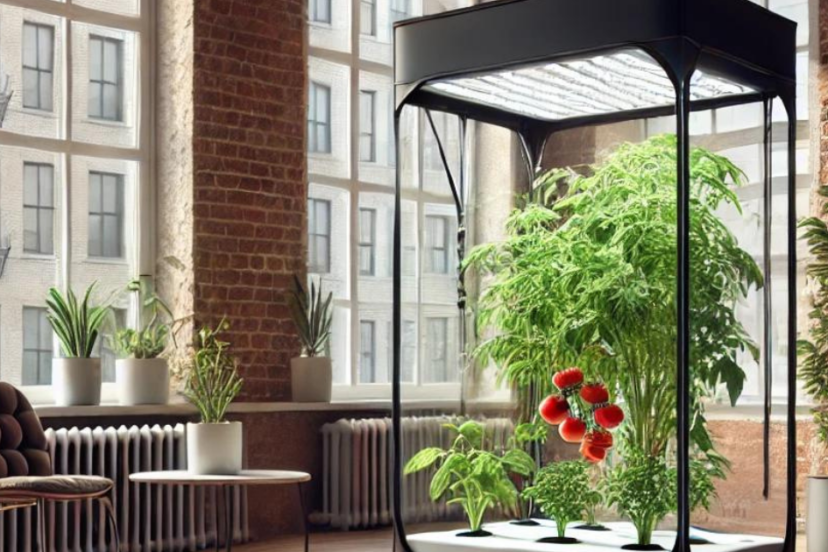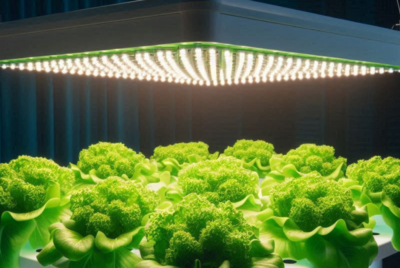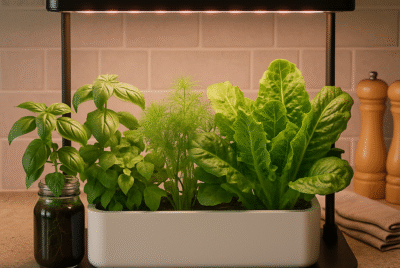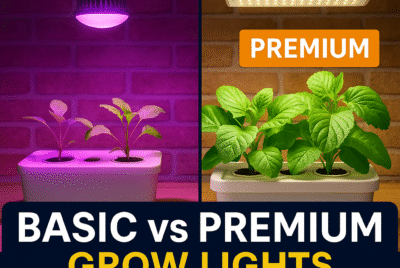Hydroponic Grow Tent: Learn 5 Growth Tips
If you’re like me, always looking for ways to improve indoor gardening, a hydroponic grow tent is a game-changer. It’s an enclosed space designed to control the environment in which your plants grow. Unlike traditional growing, which relies on outdoor conditions, a grow tent lets you create the perfect conditions for your plants to thrive, including temperature, humidity, light, and ventilation.
The key difference between a grow tent and other growing environments is the level of control. In a hydroponic tower garden or DWC hydroponics, for example, you might grow plants indoors but still struggle with temperature and light control. A grow tent fixes that by providing an enclosed, reflective environment that optimizes light and keeps out pests. If you’re using any hydroponic system—from Kratky hydroponics to ebb and flow hydroponics—a tent boosts efficiency by allowing for fine-tuned adjustments.
Here are five benefits that I’ve noticed after switching to a hydroponic grow tent:
1. Maximized Yield: By controlling the environment, plants grow faster and produce higher yields.
2. Pest Control: The enclosed space keeps pests out, and even if they get in, it’s easier to control them.
3. Energy Efficiency: The reflective material inside the tent makes the most out of your grow lights.
4. Compact Design: Great for small spaces—you don’t need an entire room for your hydroponic garden.
5. Customizable: Whether you’re using a hydroponic tower DIY or a commercial system, you can tailor the setup to your needs.
Why Use a Hydroponic Grow Tent?
The advantages of a hydroponic grow tent are numerous, but the most compelling reason for me was the control it gives. When I first started indoor gardening, I struggled with fluctuating room temperatures and humidity levels. My plants weren’t growing as well as I had hoped, and after trying everything, I finally invested in a grow tent.
A grow tent lets you control:
– Temperature: The reflective interior keeps heat inside.
– Humidity: You can control moisture levels, which is essential for hydroponics.
– Light: Grow tents block out external light and maximize the effect of your grow lights.
– Pest Prevention: The enclosed space reduces the chance of pests invading your plants.
– Odor Control: With the right carbon filter, you can keep strong plant odors under control.
Here are five recommendations for those looking to maximize space and grow efficiently indoors:
1. Use a Small Tent for Herbs and Leafy Greens: A 2×2 grow tent is perfect for a compact hydroponic tower garden.
2. Larger Tents for Flowering Plants: If you plan to grow larger or flowering plants, opt for a 4×4 grow tent.
3. Invest in Proper Ventilation: Airflow is crucial, especially for DWC hydroponics and ebb and flow hydroponics.
4. Choose Reflective Tents: Ensure your tent is lined with mylar for optimal light reflection.
5. Look for Easy Access Points: Zippers and doors that allow easy entry without disturbing the plants are a must.
Essential Features of a Hydroponic Grow Tent
Before buying a grow tent, there are several features you need to look for:
1. Light Reflection: The inside of your grow tent should have a reflective coating to maximize the efficiency of your grow lights. The reflective material allows plants to receive light from all angles, encouraging uniform growth. This is especially important if you’re using a hydroponic tower DIY setup, where vertical growth needs even light distribution.
2. Ventilation: Proper ventilation is essential in a hydroponic grow tent. Without it, you risk overheating your plants, leading to mold and poor growth. I recommend adding both intake and exhaust fans to promote airflow.
3. Water Resistance: Your grow tent will likely experience spills and high humidity. Ensure your tent material is waterproof and easy to clean.
4. Sturdy Frame: Hydroponic grow tents often house heavy equipment like lights, fans, and water systems. Make sure the tent has a sturdy frame that can support this weight.
Here are my top five grow tent recommendations based on durability, space, and ease of use:
1. Gorilla Grow Tent: Known for its thick canvas material and durable zippers. It’s pricier but perfect for long-term use.
2. VIVOSUN Hydroponic Grow Tent: Affordable and efficient, with double stitching for extra durability.
3. AC Infinity CLOUDLAB: Superior ventilation and excellent for temperature control, making it ideal for setups like DWC hydroponics.
4. Mars Hydro Grow Tent: Affordable and reflective, designed for compact spaces.
5. TopoLite Grow Tent: Great for beginners on a budget; it’s affordable but still offers solid performance.
Setting Up Your Hydroponic Grow Tent

Setting up a hydroponic grow tent is relatively simple, but there are some key things you should keep in mind for the best results. First, consider the size of the tent. If you’re working with a hydroponic tower garden, for example, you’ll need a tent that accommodates the height of the tower, which can be upwards of 6 feet.
Once you’ve chosen the right size, follow these steps:
1. Assemble the Frame:
Most grow tents come with metal poles that click into place. Make sure the frame is sturdy enough to hold your lights and fans.
2. Install the Cover:
Once the frame is set up, slip the fabric cover over the poles. Ensure that the zippers are aligned properly and that there’s no sagging in the material.
3. Set Up the Lights:
Hang your grow lights from the frame’s ceiling bars. Make sure they’re adjustable, as you’ll want to move them closer or farther from the plants depending on their growth stage.
4. Install the Fans and Filters:
Proper ventilation is critical. Attach your fans and carbon filters to the frame using clamps.
5. Place the plants and hydroponic system:
After your equipment is installed, place your plants or hydroponic system inside the tent. If you’re using a hydroponic tower garden or hydroponic tower DIY, ensure it’s centrally placed for even light distribution. For DWC hydroponics or ebb and flow hydroponics, you’ll need enough floor space to arrange reservoirs and plumbing systems.
Here are five recommendations to optimize your grow tent setup:
1. Utilize Vertical Space: If you’re working with a hydroponic tower garden, stack plants vertically to maximize space.
2. Keep Fans at Plant Level: Ensure fans are circulating air at the plant canopy level, not just above.
3. Leave Space for Maintenance: Make sure you have enough room to access and adjust equipment easily.
4. Use a Timer for Lights: Automate your lighting schedule with a timer for consistent plant growth.
5. Opt for a Drip Tray: A water-resistant tray at the base of your tent can catch spills and prevent damage.
Lighting in a Hydroponic Grow Tent
One of the most critical components of your hydroponic grow tent setup is the lighting. Plants grown indoors need supplemental light, as they’re not exposed to natural sunlight. The type of light and its intensity play a massive role in plant health and growth.
In my experience, LED grow lights are the best choice. They’re energy-efficient, produce less heat, and last longer than traditional lights. Additionally, LEDs provide full-spectrum light, which mimics the sun and is perfect for all stages of plant growth, from seedlings to flowering plants.
If you’re using a hydroponic tower DIY system, ensure the lights can cover the height of the plants evenly. For systems like kratky hydroponics or ebb and flow hydroponics, you’ll want lights that can penetrate deep into the canopy for optimal plant growth.
Here are my top five grow light recommendations:
1. Spider Farmer SF Series: Full-spectrum LEDs that are energy-efficient and perfect for both small and large grow tents.
2. Viparspectra XS Series: High-performance lights with great penetration for larger systems like DWC hydroponics.
3. Phlizon COB Series: Ideal for both veg and bloom stages, great for tall plants in a hydroponic tower garden.
4. Mars Hydro TS Series: Budget-friendly and reliable, with a wide coverage area.
5. HLG Quantum Boards: These lights are great for intense light coverage while staying energy-efficient.
Ventilation in a Hydroponic Grow Tent
Good ventilation is key to maintaining a healthy growing environment. Plants need CO₂ for photosynthesis, and without proper airflow, CO₂ levels can drop, limiting growth. Ventilation also helps manage heat and humidity levels inside the tent.
For my grow tent, I installed an inline fan and carbon filter system. The fan pulls fresh air into the tent and exhausts stale air, while the carbon filter eliminates odors. This setup works exceptionally well for hydroponic tower gardens, where multiple plants can generate a lot of moisture and odors.
Five ventilation tips for a hydroponic grow tent:
1. Install Oscillating Fans: These help keep air moving evenly throughout the tent and prevent stagnant air pockets.
2. Use Inline Fans: Ensure you have both intake and exhaust fans for proper airflow.
3. Carbon Filters for Odor: Carbon filters are excellent for controlling plant odors, especially for larger tents.
4. Keep Humidity in Check: Too much humidity can encourage mold. Use a dehumidifier if needed.
5. Check Airflow Regularly: Ensure that all plants are receiving fresh air by monitoring airflow regularly.
Choosing the Right Hydroponic System for Your Grow Tent
When it comes to choosing the right hydroponic system for your grow tent, it really depends on your space, experience level, and what you’re growing. I’ve tried several systems, from kratky hydroponics to ebb and flow hydroponics, and each one has its pros and cons.
Top Hydroponic Systems:
1. Kratky Hydroponics: This is one of the simplest systems. It doesn’t require electricity, making it ideal for small grow tents and beginners. All you need is a container, water, and nutrients.
2. Deep Water Culture (DWC) Hydroponics: This system uses air pumps to oxygenate nutrient-rich water. It’s more advanced than Kratky but allows for faster growth and bigger plants. I use this system for larger vegetables like tomatoes.
3. Ebb and Flow Hydroponics: This system works by flooding the plant roots with nutrient solution at intervals, then draining it away. It’s highly efficient for medium-sized grow tents and works well with a variety of plants.
4. Hydroponic Tower Garden: For small spaces, the vertical growth offered by a hydroponic tower DIY system is unbeatable. It’s compact, easy to maintain, and great for herbs and leafy greens.
5. Aeroponics: While more advanced, aeroponics is highly efficient. The roots of the plants are suspended in air and misted with nutrients, making it ideal for those looking to conserve water.
Here are five recommendations for hydroponic systems that work well in grow tents:
1. General Hydroponics Waterfarm: This is a DWC hydroponics system that works great for medium-sized tents.
2. Aerospring 27-Plant Vertical Hydroponic System: A compact hydroponic tower garden that maximizes vertical space.
3. VIVOSUN Hydroponic Kit: An easy-to-use kit that includes everything you need for a kratky hydroponics setup.
4. PowerGrow Systems Ebb & Flow Kit: A reliable ebb and flow hydroponics system for medium to large grow tents.
5. AeroGarden Bounty Elite: Ideal for small grow tents and those wanting an introduction to aeroponics vs hydroponics.
Nutrients and Watering Schedule for Hydroponic Grow Tents
When it comes to hydroponics, the nutrient solution is the lifeblood of your plants. Unlike traditional soil-based gardening, where plants can pull nutrients from the earth, in hydroponics, you’re in control of feeding your plants the exact nutrients they need.
For my grow tent, I’ve found that using pre-mixed hydroponics nutrients is the easiest way to ensure my plants are getting the right balance of macro and micronutrients. These nutrient solutions typically include nitrogen, phosphorus, potassium, and trace minerals.
5 Growth Tips for Managing Nutrients:
1. Choose High-Quality Nutrients: Don’t skimp on nutrients. I recommend brands like General Hydroponics or Advanced Nutrients.
2. Stick to a Feeding Schedule: Different plants require different feeding schedules. Most hydroponics systems need a nutrient change every 1-2 weeks.
3. Monitor pH Levels: Keeping your water’s pH between 5.5 and 6.5 is crucial. Anything outside this range can lead to nutrient lockout.
4. Use Hydroponic Clay Pebbles: They provide excellent drainage and aeration while supporting plant roots. It’s a great medium for most hydroponic systems.
5. Keep Reservoirs Clean: Regularly clean your nutrient reservoirs to prevent algae growth and bacteria buildup.
Here are five top nutrient product recommendations:
1. General Hydroponics Flora Series: A three-part system that gives you complete control over nutrient intake.
2. Advanced Nutrients pH Perfect: Ideal for beginners as it automatically adjusts pH levels.
3. Fox Farm Hydroponic Liquid Nutrient Trio: An organic option that works well with both DWC hydroponics and ebb and flow hydroponics.
4. Botanicare HydroGuard: A beneficial bacteria supplement that promotes root health.
5. Cultured Solutions UC Roots: A powerful nutrient solution for keeping your plants’ roots clean and healthy.
Monitoring and Maintaining Your Hydroponic Grow Tent
Once your hydroponic grow tent is up and running, it’s important to continuously monitor and maintain the environment. I use a combination of tools to make sure that my plants are thriving.
Five Monitoring Tools You Should Use:
1. Hygrometer: This measures the humidity levels in your tent, helping you adjust fans and dehumidifiers as necessary.
2. Thermometer: Keeping an eye on the temperature is essential, especially in tents with high-powered lights.
3. pH Meter: Regularly test your nutrient solution to maintain proper pH levels.
4. EC Meter: This tool measures the electrical conductivity of your nutrient solution, helping you ensure plants are receiving the correct nutrient concentration.
5. Timer: A simple timer can automate your grow lights, making sure plants receive the right amount of light each day.
Managing Pests and Diseases in Hydroponic Grow Tents
Even though a grow tent offers a controlled environment, pests and diseases can still make their way inside. The most common pests I’ve encountered in hydroponics are spider mites and aphids, which can wreak havoc on your plants if left unchecked.
Here’s how I deal with them:
1. Neem Oil: I use neem oil as a natural insecticide. It’s effective against a wide range of pests and is safe for hydroponic systems.
2. Sticky Traps: These are useful for catching flying insects like fungus gnats and whiteflies. I place them near the base of my plants to monitor pest activity.
3. Beneficial Insects: Ladybugs and predatory mites are great allies in the fight against pests. They help keep populations of harmful insects in check.
4. Hydrogen Peroxide Solution: I use a diluted hydrogen peroxide solution to treat root rot and kill off fungal spores.
5. Regular Inspections: Prevention is key. I inspect my plants daily for signs of pests or disease, focusing on the undersides of leaves and the root zone.
Top Five Pest and Disease Prevention Products
1. Neem Bliss Organic Neem Oil: Great for controlling a variety of pests, safe for hydroponics, and easy to apply.
2. Safer Brand Sticky Traps: These work well to catch flying pests before they can do serious damage.
3. Ladybugs for Pest Control: These insects can be purchased and introduced into your grow tent to control mites and aphids.
4. Mighty Mint Insect & Pest Control: A natural spray made from peppermint oil, useful for both indoor and outdoor hydroponic setups.
5. Hydrogen Peroxide (H2O2): A versatile solution for sterilizing equipment and treating fungal infections in roots.
Maximizing Growth in a Hydroponic Grow Tent
The main advantage of a hydroponic grow tent is the ability to optimize plant growth by controlling every aspect of the environment. Over the years, I’ve learned several strategies to maximize yields in my hydroponic systems.
Five Tips to Maximize Plant Growth:
1. Use a Full-Spectrum Light: Full-spectrum lights provide the best results, as they mimic natural sunlight and support all stages of plant growth.
2. Prune Regularly: Pruning helps improve air circulation around the plants and encourages better light penetration, leading to healthier plants and bigger yields.
3. Increase CO₂ Levels: Adding CO₂ to your grow tent can accelerate plant growth. I use a CO₂ generator in my setup, especially for larger tents.
4. Monitor Nutrient Strength: Plants grow faster when they’re fed the right nutrient strength. Too little and they’ll suffer from deficiencies, too much and they’ll experience nutrient burn.
5. Use a Humidity Dome for Seedlings: When starting seeds, I use a humidity dome to keep moisture levels high, which promotes faster germination.
Recommended Products for Maximizing Growth
1. Exhale CO₂ Bag: An easy-to-use CO₂ source for small to medium grow tents.
2. Trim Daddy Pruning Shears: High-quality shears that make pruning quick and efficient.
3. VIVOSUN Humidity Dome: Ideal for seedlings and clones, it helps retain moisture and increases success rates for germination.
4. Hydrofarm CO₂ Regulator Kit: A more advanced CO₂ system for larger grow tents.
5. Bluelab Truncheon Nutrient Meter: This is a must-have tool for monitoring nutrient strength and ensuring plants get what they need.
Conclusion
Setting up and maintaining a hydroponic grow tent has been a rewarding journey for me. It’s a learning process that involves fine-tuning many variables, but with the right equipment, attention to detail, and a bit of patience, you can create a highly efficient growing environment. Whether you’re experimenting with a hydroponic tower garden, trying out kratky hydroponics, or opting for ebb and flow hydroponics, a grow tent allows you to control everything from light to airflow, and even CO₂ levels, for maximum plant growth.
Using proper ventilation, selecting the right hydroponic system, and maintaining your tent’s environment will give you healthier, higher-yielding plants. Don’t forget to monitor pests, diseases, and nutrient levels regularly. And if you’re just starting, stick with simple systems like kratky hydroponics or a hydroponic tower DIY setup, and gradually move to more advanced systems like DWC hydroponics or aeroponics as you gain experience.
Finally, remember that the beauty of a hydroponic grow tent is its adaptability. Whether you’re growing herbs, leafy greens, or fruiting vegetables, the possibilities are endless. With a bit of trial and error, you’ll soon discover the best setup for your needs and enjoy the incredible results that hydroponics can offer.
FAQs
1. How do I choose the best hydroponic system for a grow tent?
It depends on your goals and the space you have. For smaller tents, a hydroponic tower garden or kratky hydroponics system is ideal. For larger spaces and more experienced growers, DWC hydroponics or ebb and flow hydroponics systems are more efficient and provide bigger yields.
2. What kind of lights should I use in a hydroponic grow tent?
I recommend using LED grow lights because they are energy-efficient, produce less heat, and provide full-spectrum light, which is perfect for all stages of plant growth. Some great options include the Spider Farmer and Viparspectra series.
3. How often should I change the nutrient solution in my hydroponic system?
Typically, you should change the nutrient solution every 1-2 weeks, but it can vary depending on the type of hydroponic system and the plants you are growing. Always monitor pH levels and nutrient strength to ensure healthy plant growth.
4. Can I use soil in my hydroponic grow tent?
No, hydroponic systems don’t use soil. Instead, plants are grown in a nutrient solution, supported by mediums like hydroponic clay pebbles. The lack of soil means you have complete control over the nutrients your plants receive.
5. How do I prevent pests and diseases in my hydroponic grow tent?
Prevention is key. Keep the tent clean, use neem oil or sticky traps to control pests, and regularly inspect your plants. Additionally, maintaining proper humidity and ventilation can reduce the likelihood of fungal diseases.
*We may earn a commission from purchases made through our links, at no cost to you. This does not affect our product recommendations. Please see our disclosure to learn more.




